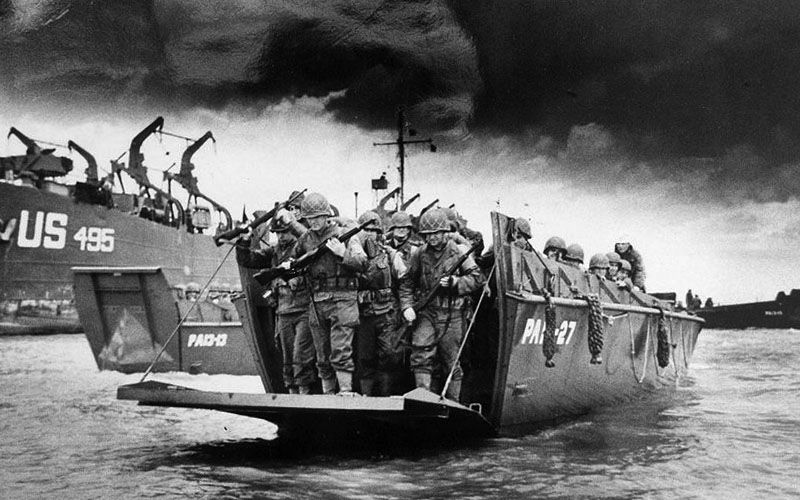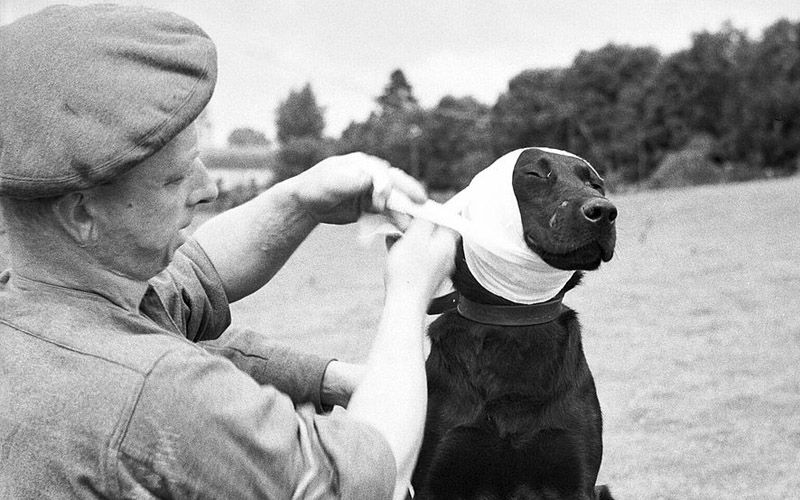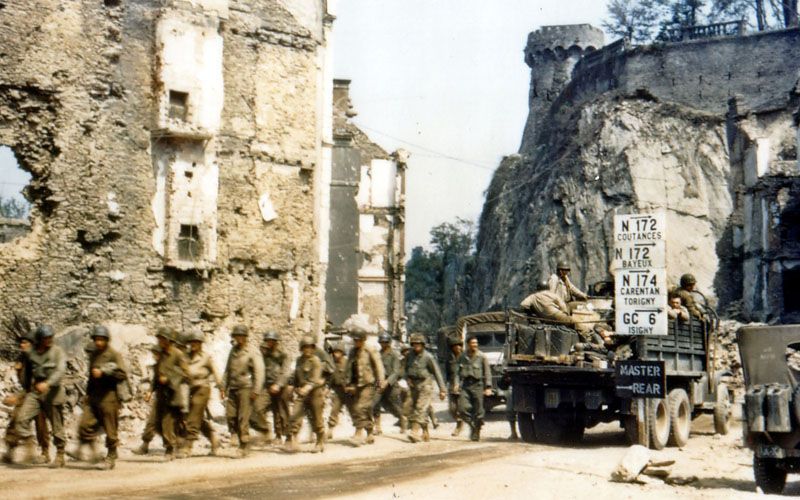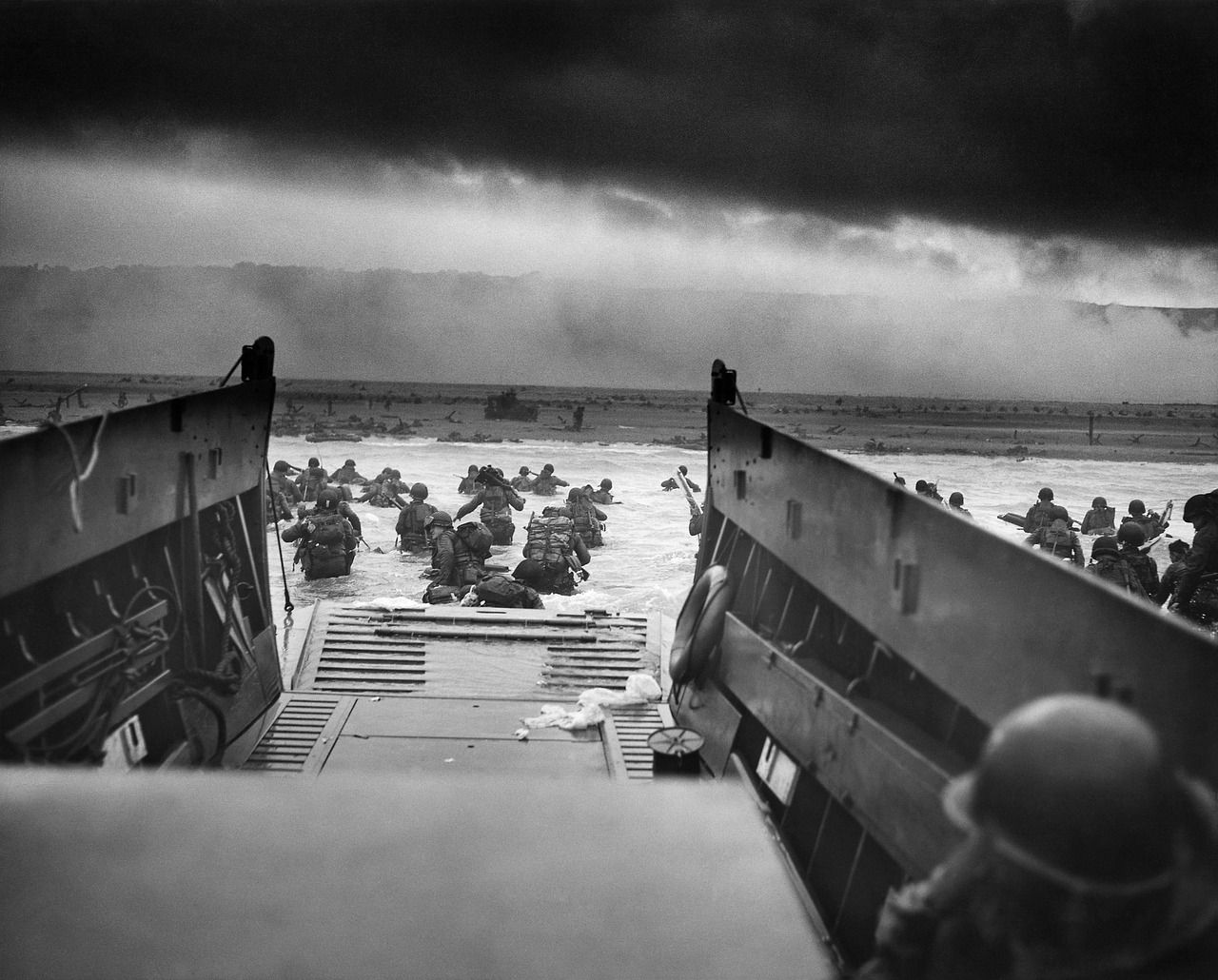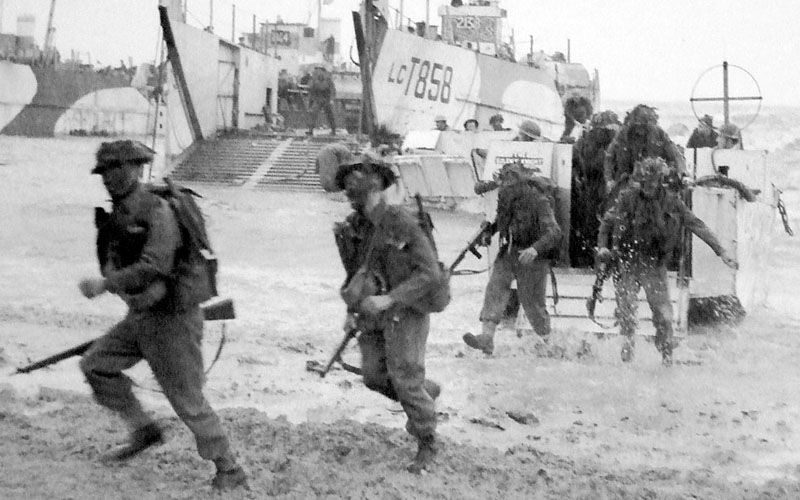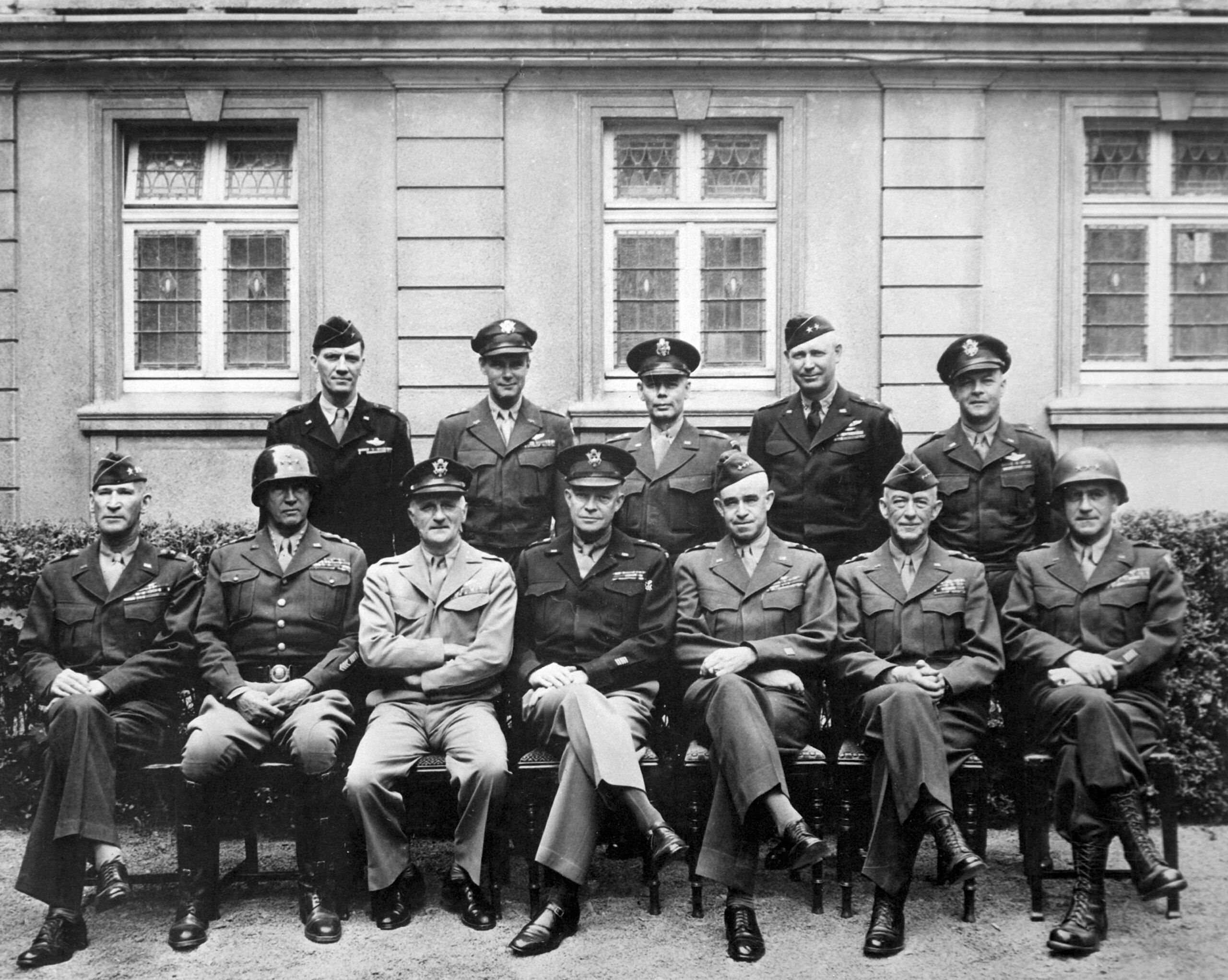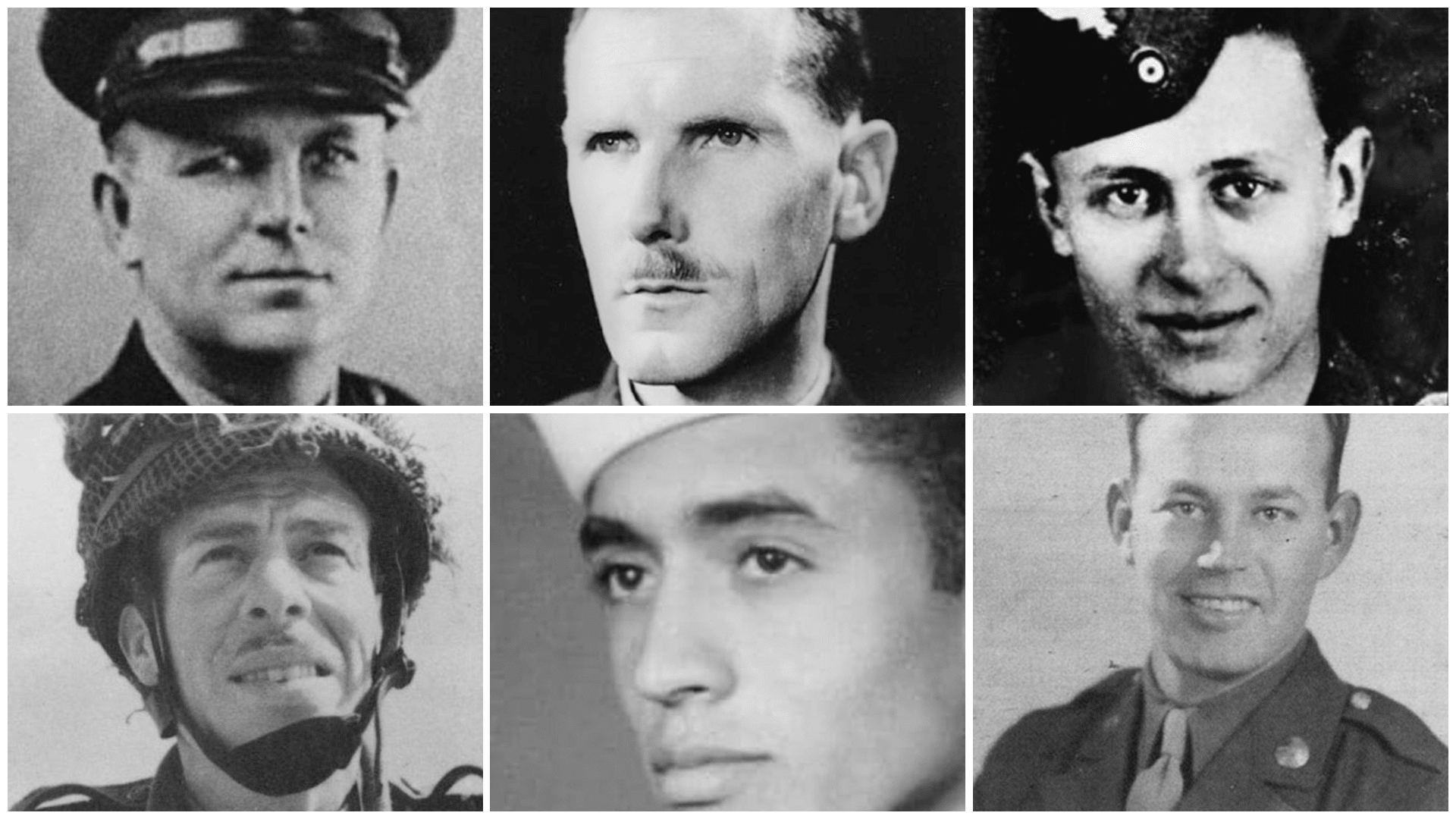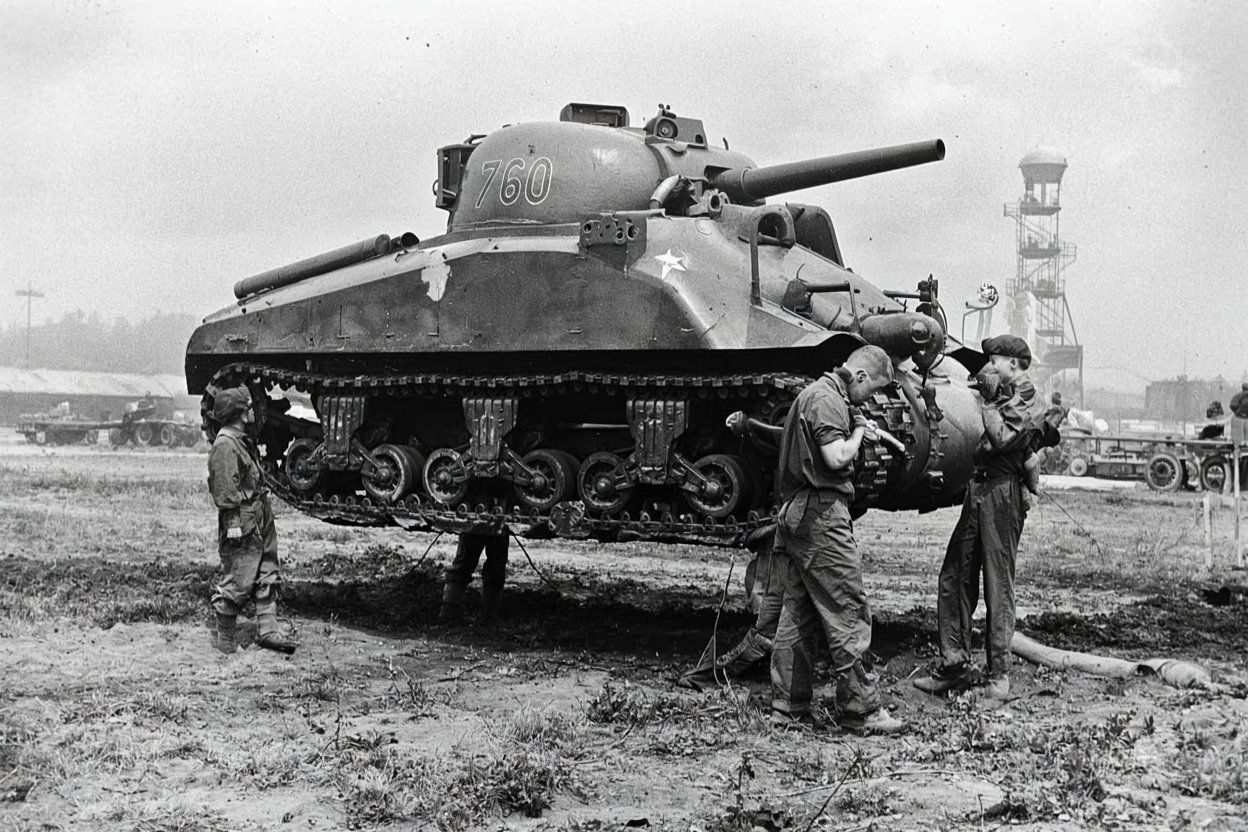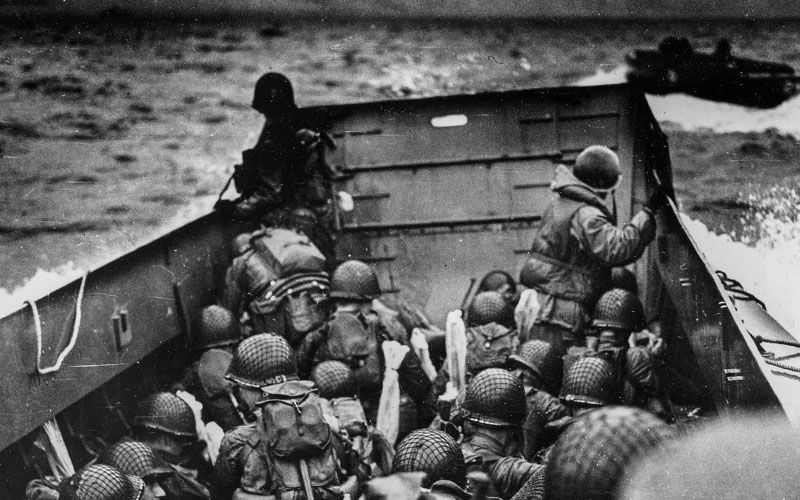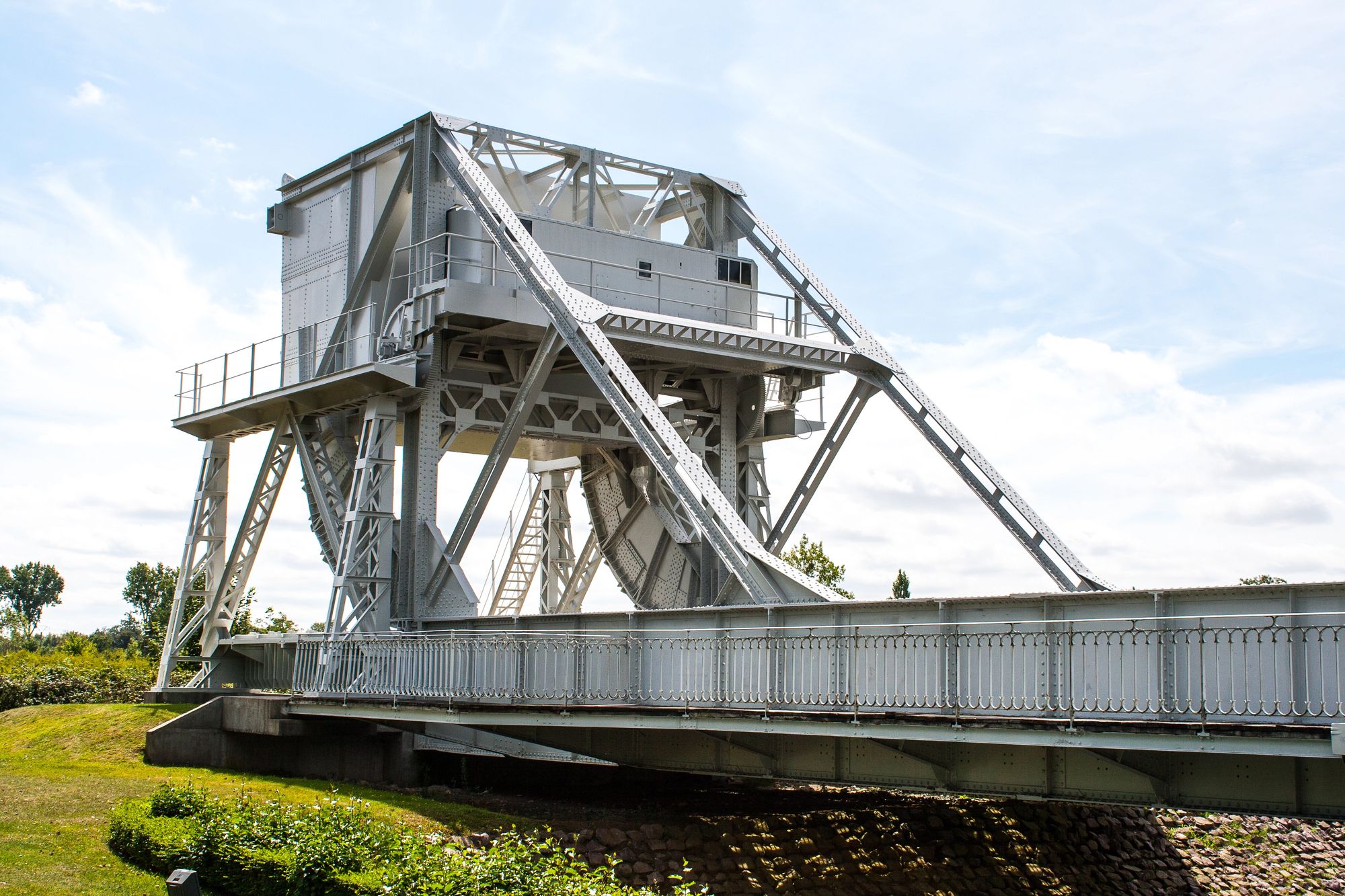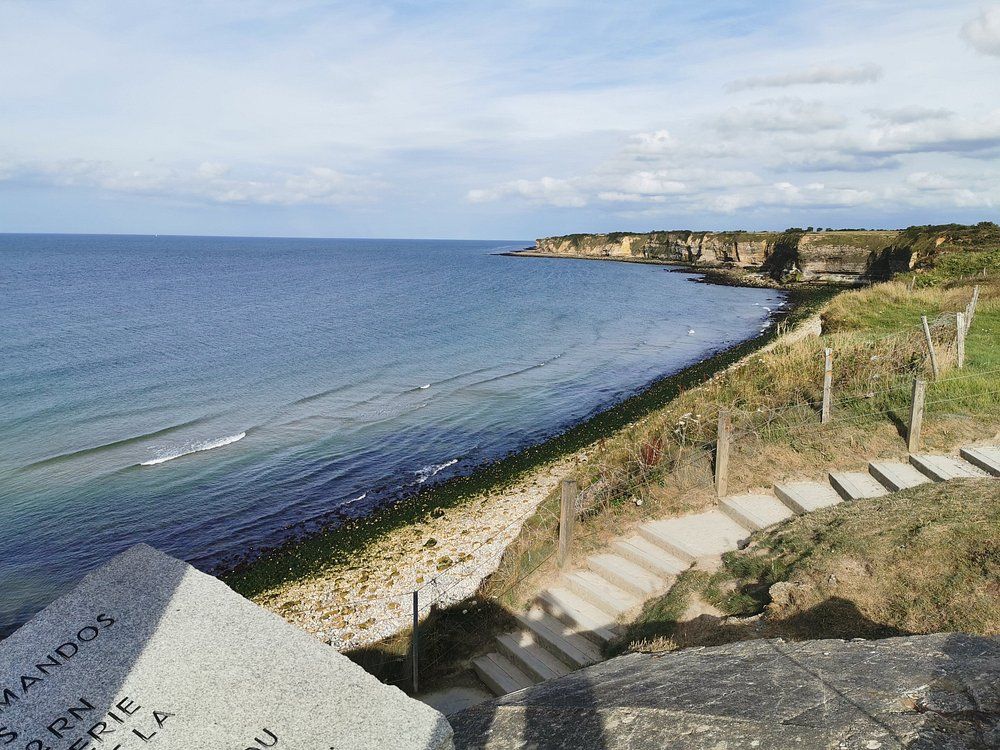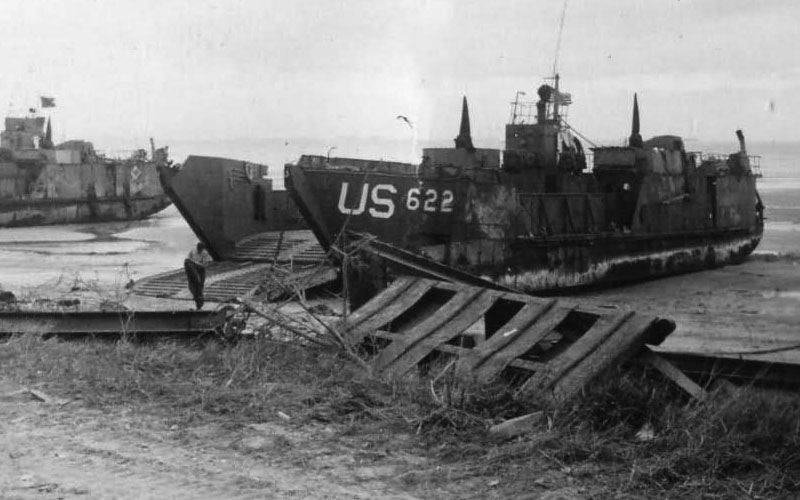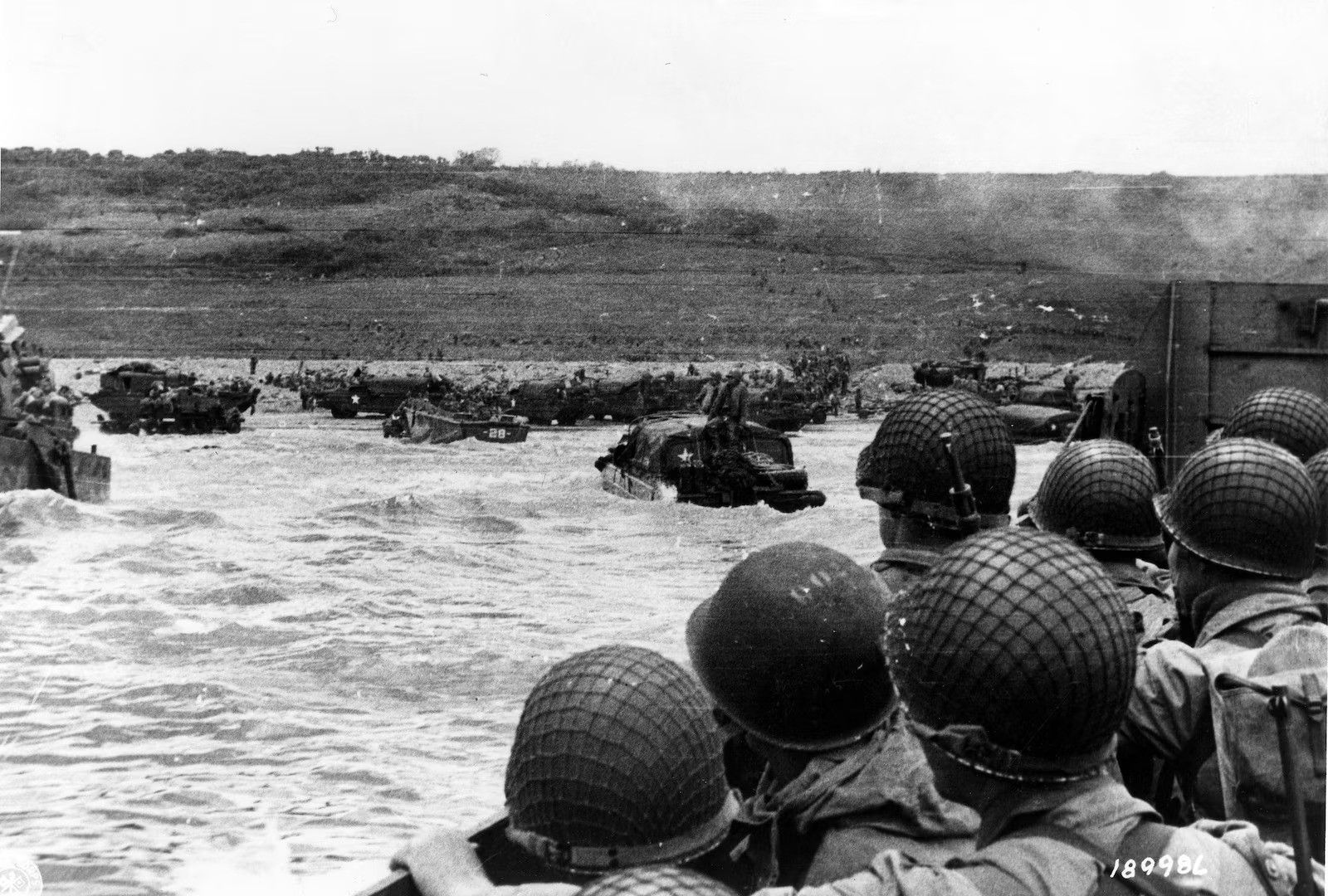All landing craft designs must find a compromise between two divergent priorities; the qualities that make a good sea boat are opposite to those that make a craft suitable for beaching.
As the technology of warfare advanced, both in terms of weaponry and vehicles, the traditional method of landing troops by conventional small boats became insufficient.
During the First World War, the use of unmodified rowing boats proved costly during the Gallipoli campaign when faced with assaulting the shores defended by Turkish forces armed with rapid-fire weapons.

In early 1915 orders were placed for the design of purpose-built landing craft, and this resulted in an order for two hundred ‘X’ Lighters (also known as “Beetles”) with a spoon-shaped bow and a drop-down bow ramp. They were first employed in combat during the August landing at Suvla Bay. Equipped with armored sides, they could travel at around 5 knots and carry approximately 500 troops.
Following World War One, the British experimented with the landing craft concept. After many arguments, the Army and Navy finally agreed to form a landing craft committee, and after establishing the necessary criteria a design was drawn up. If wasn’t until some years later, however, that a prototype Motor Landing Craft (MLC1) was constructed. Weighting 16 tons with square bow and stern, it used a waterjet propulsion system. It first put to sea in 1926 and finished trials the following year. By 1930 three were in operation with the Royal Navy.
The Munich Agreement of 1938 delayed the inevitable war between Britain and Germany, however, that same year the British Chiefs of Staff established at Fort Cumberland in Portsmouth the Inter-Service Training and Development Centre (ISTDC). It comprised one officer from each of the service branches with a Royal Marine captain acting as adjutant. Captain Loben Maund of the Royal Navy, was the Centre’s first Commandant. He had previously helped devise the manual for combined operations.

The ISTDC was tasked with being “responsible for the study and development of material, technique and tactics necessary for the success of opposed landings” (later amended to include unopposed landings). It had direct access to the Deputy Chiefs of Staff, and the Joint Intelligence Committee, but only existed for a few years. During that time, however, it was involved in a number of landing craft projects, including the development of the LCA or Landing Craft Assault (also known as the Assault Landing Craft).
The LCA was derived from a prototype designed by John I. Thornycroft Ltd. of Woolston in Southampton – just a few hundred meters from the Spitfire factory of R.J. Mitchell. Much like the wooden-framed Horsa gliders, the war effort necessitated that small companies like furniture manufacturers across the UK play a major role in their production. The LCA had a sturdy hull, good load capacity, a low silhouette and a shallow draft. The propulsion system was designed to be quiet, and at low speeds the engines could not be heard further than about 22 meters. Through its twin-screw and twin rudder arrangement it could reach a maximum speed of around 7 knots.
Typically constructed of hardwood planking and selectively clad with armor plate, the LCA operated with a crew of four and could ferry an infantry platoon of 31 troops plus five additional specialists such as sappers. It had a long central well section fitted with three benches – one each on the port and starboard sides below the top deck and another running along the center-line of the vessel. The well was divided from the bow by a bulkhead fitted with two vertically hinged armor-plated doors. These opened outwards and led to the ramp, which was lowered and raised by a simple arrangement of pulleys and wire. Two rollers on the leading outboard edge reduced friction between the ramp and ground when it was in the lowered position.
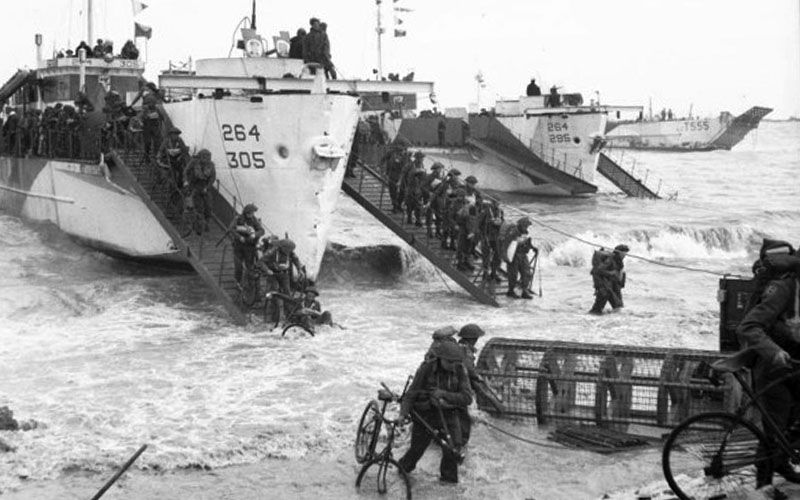
The LCA became the most common British and Commonwealth landing craft of the Second World War. Before July 1942, the vessel was more commonly known as the “Assault Landing Craft” (ALC), but to conform with the joint US-UK nomenclature system it was reclassified as “Landing Craft, Assault” (LCA). On 6th June 1944, LCAs were used to land troops the British and Canadian beaches of Gold, Juno and Sword. Some American troops at Utah Beach were also landed in LCAs as were the US Army Rangers who assaulted Pointe du Hoc.
By the end of the 1930’s on the other side of the Atlantic, after several years of conducting trials with new types of boats, the United States Marine Corps had found a design that they thought worthy of further development. The 28-foot craft had been designed by Andrew Higgin’s Eureka Tug-Boat Company of New Orleans and stood out among its contemporaries. It was both a good sea boat and excellent at beaching and was also infamous among the law enforcement community along the Gulf Coast as it was the boat-of-choice for bootleggers.
It was based on the company’s 1926 spoonbill-bowed craft used by trappers in the bayous of the Mississippi River delta. The boat’s draft was shallow, 18 inches (46 cm), and it could cut through vegetation and slide over logs without fouling its propeller. It could also run up on shore and extract itself without suffering damage. The general design of the boat was accepted by the Marine Corps, and Andrew Higgins’ company was contracted to build the 31ft blunt-bow LCP (for Landing Craft Personnel) which could carry 18 troops. From September 1940, this design was superseded by the requirement for a slightly larger version of the craft. This 36-foot vessel would officially become known as the LCP(L) – or Landing Craft Personnel (Large) – but would also be known as the Eureka boat, R-boat or T-Boat at different times.
The British had learned of the Eureka boat and been sent a film of the craft in action. Wanting a raiding craft, they placed an order with Andrew Higgins’ company for 136 of the vessels, and the first 50 were delivered in October 1940. The British specification for the boat differed slightly from that of the Americans, with the British version being slightly faster but able to carry fewer troops (25 compared to the American 30-36).
The LCP(L) still required that the soldiers it carried debark over the boat’s gunwales (or “sides”, to the non-nautical types). In April 1941, Higgins was shown a photograph of a Japanese Daihatsu-class landing craft with a bow ramp and asked if this could be developed. At his own cost Higgins incorporated this feature into the general LCP design to create the LCP(R) – or Landing Craft Personnel (Ramp).
In May 1941 tests with the LCP(R) were conducted on Lake Pontchartrain in Louisiana. The modified boat was quite seaworthy and was able to be beached and extracted without difficulty. The ramp was dropped successfully and troops and a vehicle were landed before being re-embarked. The vessel passed its official acceptance tests in June that year and soon entered service. Over 2,500 were built and it would see action in action in North Africa, Salerno, Guadalcanal and Tarawa.
The LCP(R) would be developed further into a craft known as the LCV or “Landing Craft Vehicle”. This had a much wider ramp and the ability to carry a small vehicle such as a jeep. The LCV had a raised helm position at the stern for the coxswain, meaning that the craft could not be stacked or “nested” when being transported aboard larger vessels. The design was, therefore, short-lived, but would soon be adapted into what would become the most well-known landing craft of the Second World War – the much celebrated LCVP or “Higgins Boat”. The LCVP were later described by one US Marine Corps Colonel as the “boats [that] broke the gridlock on the ship-to-shore movement”.

Made primarily of marine mahogany, at 36 feet in length the LCVP was about five feet shorter than the British LCA. Operated by just a three-man crew it could carry an entire 36-man platoon, a jeep with a 12-man squad, or about 3,600kgs of cargo provided the center of gravity was kept low. The bow ramp had a hinged section that could be opened to permit the coxswain improved visibility.
The LCVP was armed with two .30 caliber machine guns in cockpits behind the steering position. The bow ramp and sides incorporated ¼ inch “Special Treatment Steel” (STS) armor plate. The craft was powered by either a 225hp Gray Marine diesel engine or a 250hp Hall-Scott petrol engine. It has a single three-blade propeller and single rudder, although there was also a small pilot rudder mounted for forward of the screw. Top speed was around 9 knots.
If Higgins had not designed and built those LCVPs, we never could have landed over an open beach. The whole strategy of the war would have been different.
- Dwight D. Eisenhower, former President of the United States (1964)
The general LCVP design was built by eight different manufacturers, and although they all essentially confirmed to the same Navy specification and Higgins’ design, some manufacturers could not duplicate the exact detail of the Higgins Industries boats. The companies involved were Higgins Industries itself, of course, along with Chris-Craft, Owens Yachts, Chamberlain Corporation, Dodge Boat and Plane Corporation, Mathews Corporation, Richardson Boat Company and from 1943 the US Army’s 411th Engineer Base Shop Battalion based in Cairns, Australia.
By 1943, Higgins Industries employed some 20,000 people and operated from seven plants. By September of that year the U.S. Navy had 14,072 vessels in its inventory, and of these a total of 12,964 craft (or 92%) had been designed by the company. At the peak of production Andrew Higgins’ company was turning out 700 boats a month – more than all other shipyards in the nation combined – and by the end of the War more than 23,000 LCVP had been built. The company was also producing parts for the Manhattan Project.
Smaller landing craft like the LCVP were often deployed from US Navy ships known as Attack transports. The attack transports were designed or modified to carry their own fleet of landing craft, so as well as carrying troops and equipment they also carried the transport needed to land them ashore. A total of 388 APA (troop) and AKA (cargo) attack transports were in service during the Second World War in at least fifteen classes. Depending on class they were armed with one or two 5-inch guns and a variety of 40 mm and 20 mm anti-aircraft weapons.
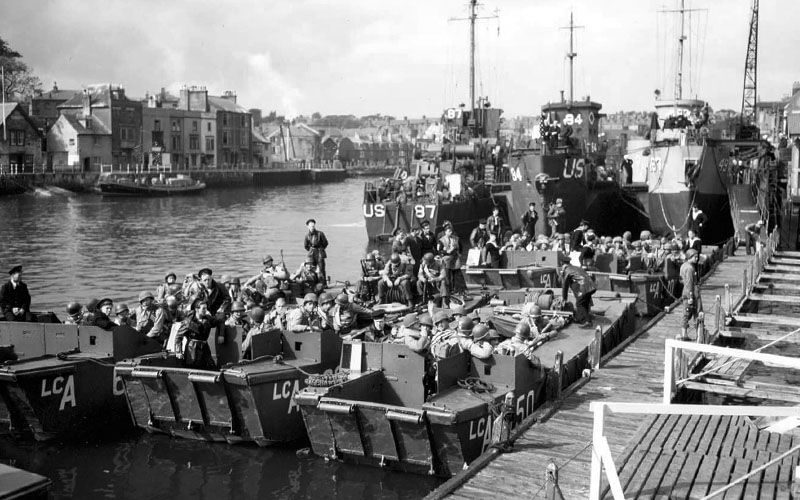
The APA and AKA ships would not land troops directly, but would wait out of the range of enemy fire whilst their smaller boats were deployed from davits, before assembling for the run in to shore. The markings often noted on landing craft, such as PA13-22, denoted the mother ship for a particular landing craft along with the crafts individual number. APA13, for example, was the USS Joseph T. Dickman, a converted civilian passenger/cargo liner which carried troops destined for Utah Beach on D-Day.
Increased requirements for larger or more specialized craft resulted in a panoply of landing vessels, ranging in size from small craft of a few tons displacement to ocean-going ships weighing in at many thousands of tons. Dozens of different applications were addressed, including rocket-firing vessels, ships for fighter direction, headquarters ships, and ships designed to carry other ships. There were also unpowered landing barges, such as the “LBF” or “Landing Barge, Flak” and self-propelled amphibious vehicles like the “LVT” or “Landing Vehicle, Tracked”.
In Normandy, three types craft in particular stand out as playing a key role in landing troops and equipment on D-Day and during the period of the Battle of Normandy.
The “LCI(L)” or “Landing Craft, Infantry (Large)” was developed in response to a British request for a vessel capable of carrying and landing substantially more troops than the smaller vessels like the LCA and LCVP. The resulting vessels were of several classes, but designed to carry 200 troops at up to 15 knots and be as capable at landing as the LCA. The term landing “craft” is rather a misnomer, as the LCI(L) was a ship that displaced almost 400 tons when loaded and had a possible range of thousands of miles.
Nobody dashed ashore. We staggered. With one hand I carried my gun, finger on the trigger; with the other I held onto the rope-rail down the ramp, and with the third hand I carried my bicycle.
- Cpl. Peter Master, 10 Commando (Sword Beach)
The original British design was envisioned as being a one-time use and were considered an expendable asset. As such, no accommodation was provided for the troops it carried. This was changed when it was realized that many operations would require overnight accommodation. Although, a galley and toilet facilities were included, a maximum of 48 hours was specified in naval documentation for troops to be embarked.
In the United States, an easily built and mass-producible design was developed, making use of non-traditional shipbuilding facilities and equipment. Ten different locations would build the LCI(L) with the first of a total 923 ships entering service in 1943. Most of the vessels were operated by the US Navy, with 211 being provided to the Royal Navy under the Lend-Lease program.
The original design, consisting of several hundred vessels, made use of gangways either side of the bow. The gangways would be lowered to allow troops to disembark, although their position left the soldiers rather exposed to enemy fire. Later versions of the ship instead incorporated a single enclosed ramp behind two doors in the vessel’s bow, affording slightly better protection to those disembarking.
Another vessel – the “Tank Landing Craft” (later renamed the “Landing Craft, Tank” or “LCT” in compliance with US military nomenclature) was initially built by the Royal Navy and later by the US Navy. Between 1940 and 1944 eight different versions existed ranging in size and capacity, but all shared the ability to deliver at least three tanks or other cargo over a distance of hundreds, some even thousands, of miles. All were armed with a least two 20-mm guns and in general crewed by one or two officers and 10-12 enlisted men.
The Mark 1 was first launched in November 1940 and had an all-welded steel hull. It had a draft of just 3 feet at the bow, and a 12-foot wide hinged ramp enabled tanks to exit directly onto the beaches. During sea trials it was found to be difficult to handle and only 30 of this type were built, and seventeen were lost during the evacuation of Dunkirk. The Mark 2 LCT addressed the some of the faults with original design and was longer, wider and increased armor to the wheelhouse and gun tubs. Seventy-three Mark 2s were built.
The LCT Mark 3 was 32ft longer at 192 feet and had a displacement of 640 tons. Despite the additional weight, the vessel was slightly faster than the Mark 1 and could carry five 40-ton tanks and related support equipment, or 300 tons of deck cargo. The craft did, however, enter service without sufficient testing as combat operations demonstrated the need to add longitudinal stiffeners to both the Mark 3s and later the Mark 4s in order to avoid torsional stresses to the hull. Two hundred and thirty-five Mark 3s were built.
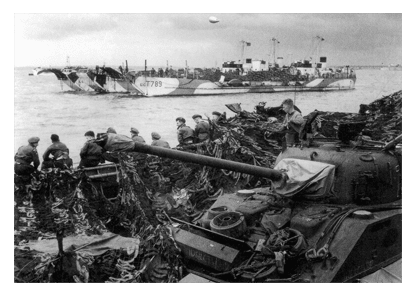
The LCT Mark 4 was slightly shorter and lighter than the Mark 3, but had a much wider beam at just over 38 ft. It was intended for cross-channel operations as opposed to deep sea use. Better accommodation for tank crews was also made possible by the increased beam. It had a displacement of 586 tons with a capacity of 350 tons. It could carry nine Sherman or six Churchill tanks. More than 850 Mark 4s were built – the largest production from British shipyards of any of the LCT versions.
The Mark 5 was the first of the American-designed LCTs and became the standard LCT in production until itself superseded by the Mark 6. These two versions had the unusual ability of being able to be shipped to combat areas in three separate water-tight sections aboard a cargo ship or be carried pre-assembled on the flat deck of an LST (“Landing Ship, Tank” – see below). By heeling the LST to one side or the other, the craft could be slid off its chocks and into the water. If carried in sections, the individual parts were lowered into the water and assembled whilst afloat.
Larger and with greater range and carrying capacity than the LCT was the LST or “Landing Ship, Tank”. Several variants were designed during the War, but all were of similar design – equipped with a large set of bow doors behind which a ramp was located. The LST’s flat keel allowed the ship to beach and fully “dry out” whilst remaining upright. The twin propellers and rudders had protection from grounding.
Some of the original LSTs were converted shallow-draft tankers originally built to pass over the restrictive bars of Lake Maracaibo in Venezuela. HMS Boxer was the first purpose-built LST designed by the British. In addition to its crew, it could carry 200 men, 13 Churchill tanks and 27 other vehicles at a speed of 18 knots. Boxer and her two sister vessels, “Bruiser” and “Thruster” were later converted to Fighter Direction Ships for the Normandy landings. British and American departments collaborated on the improved designs for a Mark 2 LST. It incorporated elements of the first British LCTs including sufficient buoyancy to keep the ship afloat even when the tank deck was flooded. To meet the conflicting requirements of deep draft for ocean travel and shallow draft for beaching, the Mark 2 was designed with a ballast system sufficient that it could be filled for ocean passage and pumped out for beaching operations. An anchor and mechanical winch system was also incorporated, aiding in the ship’s ability to pull itself off the beach.
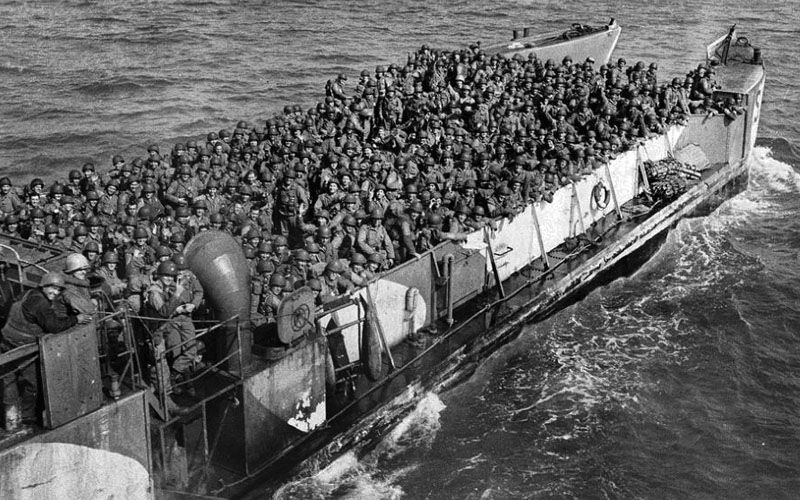
A high priority was assigned to the construction of LSTs. A keel that had been laid for aircraft carrier was even removed to make room for several LSTs to be built in its place. The keel of the first LST was laid down on 10 June 1942 at Newport News, Virginia, and the first standardized LSTs were floated out of their building dock in October. Twenty-three were in commission by the end of 1942.
Because the typical coastal shipyards were in using constructing larger ships, the construction of LSTs mainly took place at “cornfield shipyards” along inland waterways using plants converted from heavy-industry. Movement of the vessels was made more difficult by bridges along the route and many were modified by the Navy to permit passage. A dedicated Navy “Ferry Command” managed the transportation of newly built ships to coastal ports for final fitting out.
As fabrication techniques were developed, both costs and construction time for building LSTs reduced. By 1943, an LST could be built in just four months, and by the end of the war this had been cut further to two months. Over 1,000 LSTs Mark 2s were built, and although considerable efforts were made to keep the design constant by mid-1943 certain changes were introduced based on operation experience.
The elevator installed in the earlier vessels to transfer equipment between the tank deck and the main deck was replaced by hinged ramp. This allowed vehicles to be driven directly from the main deck onto the tank deck and then across the bow ramp to the beach or causeway, speeding the process of disembarkation. Later modifications included the addition of a navigation bridge; the installation of a water distillation plant; the strengthening of the main deck in order to carry the smaller Landing Craft Tank (LCT); and an upgrade in armor and armament.
A much smaller number of Mark 3 LSTs were designed to be built in Canada and Britain for delivery in the spring of 1945. The British specifications included the ability to carry five LCA or similar craft along with one LCT Mark 5 or Mark 6 on the upper deck. They were also required to be able to carry 500 tons of cargo and hold sufficient fuel and stores for a 1,000 mile return journey at 10 knots.
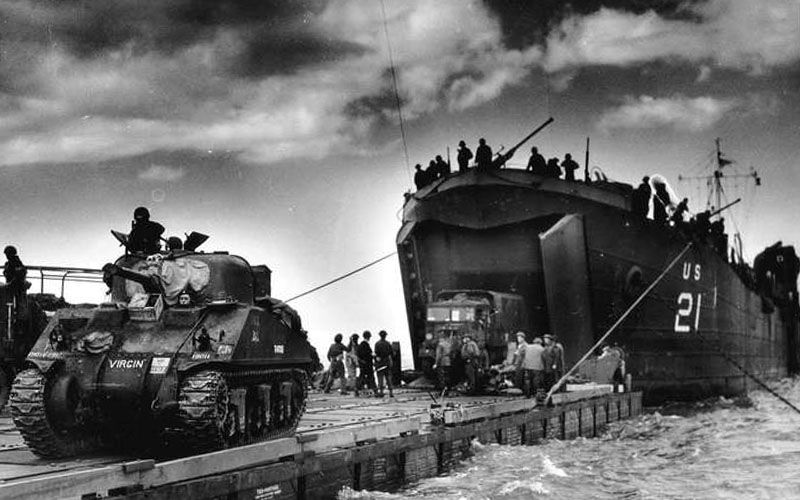
The first ships were delivered in December 1944. Fifteen 40-ton tanks or twenty-seven 25-ton tanks could be carried on the tank deck with an additional fourteen lorries on the main deck. The bow door arrangements were similar to the LST Mark 2, but the design arranged the bow ramp in two parts in an attempt to increase the number of beaches where direct discharge would be possible. The end of the war interrupted the program, and of the planned 119 Mark 3 LSTs only around half were completed.
It was something which you just can’t imagine if you have not seen it. It was boats, boats, boats and more boats, boats everywhere.
- Jacqueline Noel, French civilian (Recalling the British beaches. She met her future husband on D+4)
Despite the huge numbers of landing craft and landing ships of all types and variations built during the War, there are relatively few survivors today.
None of the British LCAs survive in museums, although several original craft used by Colonel Rudder’s 2nd Rangers in the raid on Pointe-du-Hoc are in private hands and slowly undergoing restoration. Information on this project is very sketchy, although it is rumored that one of the craft may form the centerpiece of a new Ranger museum in Normandy.
At least one example of an original LCVP is still in working order. Operated by a French team and berthed in Carentan, the LCVP 9386 did not serve in Normandy in 1944, but is a genuine 1942-built example constructed at Higgins Industries plant in New Orleans. During the annual D-Day anniversary commemorations it can sometimes be seen landing re-enactors on Utah Beach. More information can be found at the Challenge LCVP website.
Quite a few museums have examples of the Higgins Boat on display, including the Utah Beach Museum, Musée Mémorial d’Omaha Beach and the First Division Museum at Cantigny in France; the National World War II Museum in New Orleans and Washington D.C.’s National Museum of the United States Navy in the United States; and the D-Day Story at Portsmouth in the UK.
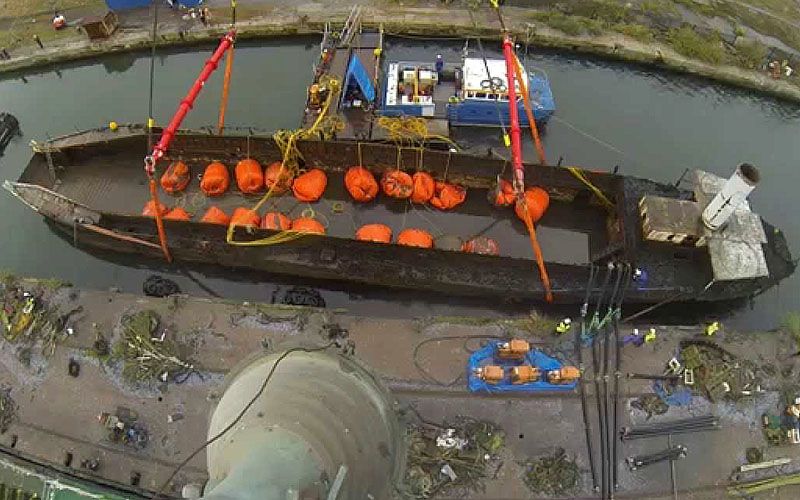
At the Musée D-Day Omaha in Vierville-sur-Mer, there are several LCVP craft outside the museum. These are unrestored examples and look rather the worse for wear. Between the car park and the museum is an even rarer craft in the form of an LCP(L). Again, looking neglected and exposed to the elements, this is an example of the version built for the British Admiralty without the machine gun pits behind the bow.
Two LCI(L) also survive in the United States. Hulls from several other LCI(L)s have also been repurposed over the years, including for Circle Line sightseeing tours in New York harbour. Although none of these vessels took part in Operation Overlord they exist as important examples of this type of ship.
Two Landing Ships, Tank, LST-325 and LST-393, both of which delivered troops and equipment to the Normandy beaches survive as museum ships in the United States. LST-325 is still a fully-functioning vessel. Another example, formerly LST-510, survives in a heavily modified condition serving as a passenger and vehicle ferry between Delaware and New Jersey.
In 2014, the last surviving LCT was re-floated from a shallow, watery grave in Birkenhead docks. It was later transported to the Royal Naval Dockyard in Portsmouth where it us undergoing restoration. In 2019 in time for the 75th Anniversary of D-Day, it is due to be placed on display outside the D-Day Story (formerly the D-day Museum) at Portsmouth.

